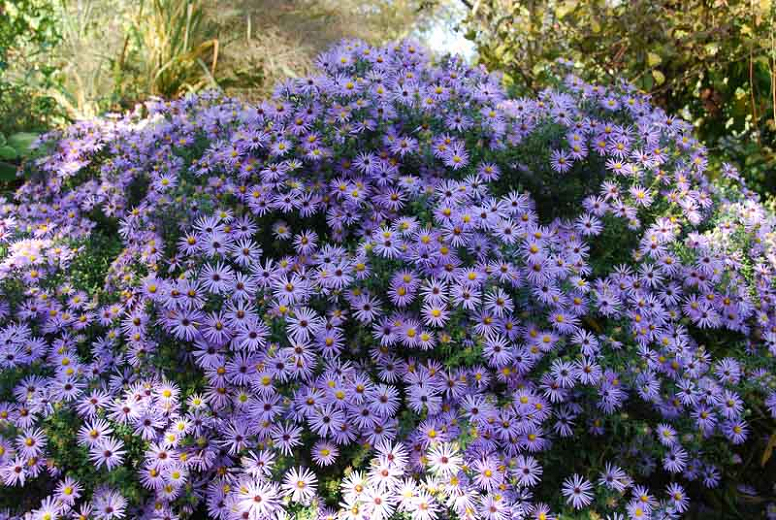Symphyotrichum oblongifolium: Aromatic Aster

Latin name: Symphyotrichum oblongifolium
Common name: Aromatic Aster
Flowers: Violet ray and yellow disk flowers emerge September – November10,12
Fruit: Flat hairy achenes16
Height & Width: 1-3’ x 1-3’12
Type: Herbaceous perennial12
Habit: Low growing, clumping11,12
Wetland indicator category**: Not available
Texture: Coarse12
Growth rate: Fast10
Light: Full sun12
Moisture: Dry-medium12
Soil*: Well drained soil, sandy or clay, neutral-slightly acidic10,12,16
Zones: 3-812
Origin: L4816, Eastern US11
Ecosystem benefits: Flowers attract and feed many insects and animals including butterflies and birds, can be used for wildlife habitat restoration12,16
Features: This plant has showy purple flowers throughout the fall that will attract many insects, butterflies and birds. It is a low growing plant that has very aromatic leaves12.
Siting: This plant will do best in sunny, well drained areas. It can tolerate rocky, sandy, clay or disturbed soils. It is most often planted in groupings within native gardens12.
Care: Plant crown at soil level18. At planting, water the roots and surrounding area slowly and deeply. Keep soil moist until plant is established, then apply enough water to thoroughly moisten the root zone when the soil is dry or during drought. Modify water recommendations to reflect site drainage and rainfall. Apply 3” of mulch over the planted area. Do not allow mulch to touch the plant stems18.
Pests: Plants are relatively pest resistant if cultural preferences are met12.
This plant does not appear on the following invasive plant lists on (10/28/20):
X USDA SC Invasive Plant Species Web site at http://www.invasivespeciesinfo.gov/plants/main.shtml
X SC Exotic Plant Pest Council Web site at http://www.se-eppc.org/southcarolina/
Author: Kerrie McCaffrey
Image source: https://www.gardenia.net/plant/aster-october-skies
Sources:
-
Armitage, A. (2001). Armitage’s manual of annuals, biennials, and half-hardy perennials. Portland, OR: Timber Press.
-
Armitage, A. (2006). Armitage’s native plants for North American gardens. Portland, Oregon: Timber Press.
-
Armitage, A. (2008). Herbaceous perennial plants: A treatise on their identification, culture, and garden attributes. Athens, GA: University of Georgia.
-
Clemson Cooperative Extension Home and Garden Information Center.(2011). Flowers fact sheets. Retrieved from http://www.clemson.edu/extension/hgic/plants/landscape/flowers/
-
Clemson Cooperative Extension Home and Garden Information Center.(2011). Groundcovers & vines fact sheets. Retrieved from http://www.clemson.edu/extension/hgic/plants/landscape/groundcovers/
-
Clemson Cooperative Extension Home and Garden Information Center. (2011). Trees. Retrieved from http://www.clemson.edu/extension/hgic/plants/landscape/trees/
-
Clemson Cooperative Extension Home and Garden Information Center.(2011). Shrubs. Retrieved from http://www.clemson.edu/extension/hgic/plants/landscape/shrubs/
-
Dirr, M. A. (2009). Manual of woody landscape plants. Champaign, IL: Stipes Publishing.
-
Gilman, E. F. (1997). Trees for urban and suburban landscapes. Albany, NY: Delmar Publishers.
-
Lady Bird Johnson Wildflower Center University of Texas at Austin. (2012). Native plant information network. Retrieved from http://www.wildflower.org/explore/
-
McMillan, P., Plant taxonomist Clemson University, personal communication.
-
Missouri Botanical Garden Kemper Center for Home Gardening. Plant finder. Retrieved from http://www.mobot.org/gardeninghelp/plantfinder/Alpha.asp
-
North Carolina State University (2005). Plant fact sheets. Retrieved from http://www.ces.ncsu.edu/depts/hort/consumer/factsheets/index.html
-
Strother, E. V., Ham, D. L., Gilland, L. (2003) Urban tree species guide: Choosing the right tree for the right place. Columbia, SC: South Carolina Forestry Commission.
-
University of Florida, IFAS Extension. (2011). Southern trees fact sheet. Retrieved from http://edis.ifas.ufl.edu/department_envhort-trees
-
USDA. Plant profile. (n/d).Retrieved from http://plants.usda.gov/java/
-
USDA. Plant wetland indicator status. (n/d). Retrieved from http://plants.usda.gov/wetland.html
-
Vincent, E., Environmental horticulturist Clemson University, personal communication.
-
Clemson Extension. Carolina Yards Plant Database. Retrieved from https://www.clemson.edu/extension/carolinayards/plant-database/index.htm
*Soil pH is determined using a professional soil test. Contact your Clemson University County Extension service for assistance www.clemson.edu/extension/. Click on “local offices”.
**2012 Plant Wetland Indicator categories (quantitative derived) http://plants.usda.gov/wetinfo.html
|
Indicator Code |
Indicator Status |
Comment |
|
OBL |
Obligate Wetland |
Almost always is a hydrophyte, rarely in uplands |
|
FACW |
Facultative Wetland |
Usually is a hydrophyte but occasionally found in uplands |
|
FAC |
Facultative |
Commonly occurs as either a hydrophyte or non-hydrophyte |
|
FACU |
Facultative Upland |
Occasionally is a hydrophyte but usually occurs in uplands |
|
UPL |
Obligate Upland |
Rarely is a hydrophyte, almost always in uplands |
